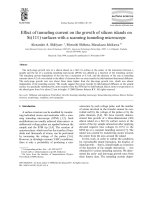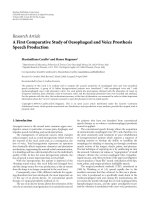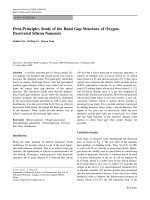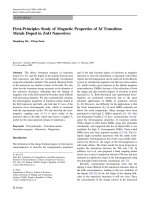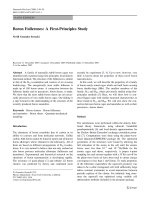First principles study of benzene adsorption on transition metal surfaces
Bạn đang xem bản rút gọn của tài liệu. Xem và tải ngay bản đầy đủ của tài liệu tại đây (2.11 MB, 142 trang )
FIRST PRINCIPLES STUDY OF BENZENE ADSORPTION
ON TRANSITION METAL SURFACES
HONG WON KEON
NATIONAL UNIVERSITY OF SINGAPORE
2008
FIRST PRINCIPLES STUDY OF BENZENE ADSORPTION
ON TRANSITION METAL SURFACES
HONG WON KEON
(B. Eng.(Hons.), Sungkyunkwan University, Republic of Korea)
A THESIS SUBMITTED
FOR THE DEGREE OF MASTER OF ENGINEERING
DEPARTMENT OF CHEMICAL & BIOMELEULAR ENGINEERING
NATIONAL UNIVERSITY OF SINGAPORE
2008
ACKNOWLEDGEMENTS
I would like to express my sincere appreciation to my supervisor, Prof. Mark Saeys, for
his encouragement, insight, support and incessant guidance throughout the course of this
research project. I am extremely grateful to him for spending so much time on explaining
my questions on the research work and sharing his broad and profound knowledge with
me. I also feel thankful to his high integrity and dedication in the scientific research,
which have greatly inspired me.
I am very thankful to Ms Khoh Leng Khim, Mdm. Jamie Siew, Mr. Mao Ning, Mr. Chia
Phai Ann, Dr. Yuan Ze Liang, Ms Lee Chai Keng, Mdm Sam Fam Hwee Koong, Ms Tay
Choon Yen, and Shang Zhenhua for their technical and kind support.
I would sincerely like to thank our group members Xu Jing, Sun Wenjie, Tan Kong Fei,
Zhuo Mingkun, Fan Xuexiang, Su Mingjuan and Ravi Kumar Tiwari for many useful
discussions and their help in carrying out my research work in the lab. I also thank all my
friends both in Singapore and abroad, who have enriched my life personally and
professionally.
Finally, special thanks must go to my family for their kind understanding, encouragement,
and support during my pursuit of M. Eng. degree.
i
TABLE of CONTENTS
ACKNOWLEDGEMENTS ···························································································· i
TABLE OF CONTENTS ······························································································· ii
SUMMARY ···················································································································· v
SYMBOLS AND ABBREVIATIONS········································································· vii
LIST OF TABLES ········································································································· ix
LIST OF FIGURES········································································································ xi
CHAPTER 1 Introduction ·······························································································1
1.1 First Principles-based Modeling ···········································································1
1.2 Principles in Heterogeneous Catalysis···································································3
1.3 Application of First Principles-based Modeling ····················································7
1.4 Electronic Interaction in Heterogeneous Catalysis ··············································10
1.4.1 Surface-adsorbate Interaction·········································································11
1.4.1.1 CO Interaction with the Pt(111) Surface ················································12
1.4.1.2 C2H4 Interaction with the Pd(111) Surface ·············································13
1.4.2 Adsorbate-adsorbate Interaction ····································································15
1.4.3 Electronic Interaction on Benzene Adsorption on Pt(111) ····························16
1.5 Organization of the Thesis ·················································································20
1.6 References···········································································································21
CHAPTER 2 Computational Method ·············································································23
2.1 First Principles Quantum Chemical Methods ······················································23
2.1.1 Time Independent Schrödinger Equation ·······················································23
2.1.2 Hartree-Fock Approximation·········································································25
2.1.3 Electron Correlation Methods········································································27
2.2.3.1 Configurational Interaction·····································································28
2.2.3.2 Møller-Plesset Perturbation Theory ························································29
2.2.3.3 Coupled-Cluster Theory ·········································································30
ii
2.1.4 Density Functional Theory (DFT) ································································31
2.1.5 Exchange-Correlation (XC) Functionals ·······················································33
2.2.5.1 Local Density Approximation (LDA) ····················································33
2.2.5.2 Generalized Gradient Approximation (GGA) ········································34
2.1.6 Basis Sets ······································································································36
2.1.7 Plane Wave Basis Sets ··················································································40
2.1.8 Pseudopotentials ···························································································41
2.2.8.1 Norm-Conserving (NC) Pseudopotentials ··············································43
2.2.8.2 Ultra-Soft (US) Pseudopotentials ···························································43
2.2.8.3 Projector Augmented Wave (PAW) Method ·········································45
2.2 Computational Codes ·························································································47
2.2.1 Vienna Ab-initio Simulation Package (VASP) ·············································47
2.2.2 Gaussian03 (G03) ··························································································47
2.3 References ··········································································································49
CHAPTER 3 Benzene Chemisorption on Pt(111) ·························································51
3.1 Converged DFT Benzene Adsorption Energy on Pt(111) ··································52
3.1.1 Review of the Literature: Benzene Adsorption Studies on Pt(111) ···············54
3.1.2 Convergence Test for DFT Benzene Adsorption Energy on Pt(111) ············59
3.1.2.1 Convergence Test on Vacuum Thickness ··············································63
3.1.2.2 Convergence Test on the number of k-points and the Slab Thickness ···63
3.1.3 Electronic Analysis of DFT Benzene Adsorption Energy on Pt(111) ··········65
3.1.4 Summary ······································································································73
3.2 Accuracy of DFT Adsorption Energy on Pt(111) ··············································74
3.2.1 Review of Computational Studies of CO Adsorption on Pt(111) ················75
3.2.2 Exchange-Correlation (XC) Correction Approach ·······································81
3.2.2.1 DFT Adsorption Energy in a Periodic Slab Calculation ·························82
3.2.2.2 DFT-PBE Adsorption Energy on a Small Cluster in VASP ···················82
3.2.2.3 DFT-PBE Adsorption Energy on a Small Cluster in G03 ······················85
3.2.2.4 DFT-B3LYP Adsorption Energy on a Small Cluster in G03 ·················92
3.2.2.5 Adsorption Energy on a Small Cluster validated with correlated
wavefunction based methods ·············································································94
3.2.2.6 Comparison with wave function based methods: binding energy of di-σ and
π ethylene on a small Pt2 cluster ········································································97
3.2.3 Electronic Structure based Correction Approach ·········································98
3.2.3.1 HOMO-LUMO gap of Gas Phase Molecules ········································99
iii
3.3 Coverage Effects on the Benzene Adsorption Energy and Site Preference on
Pt(111) ···················································································································105
3.3.1 Review of the Experimental and Theoretical Literature on the Coverage Effects
on Benzene Adsorption on Pt(111) ····································································105
3.3.1.1 Preferential Adsorption Mode for Benzene at High Coverage ············105
3.3.1.2 Chemisorbed Benzene Structure as a Function of Coverage ···············106
3.3.1.3 Benzene Adsorption Energy as a Function of Coverage ·····················107
3.3.2 DFT Study of the Coverage Effect on the Benzene Adsorption Energy ·····108
3.3.2.1 Preferred Benzene Adsorption Sites at High Coverage ·······················109
3.3.2.2 Coverage Effect on the Benzene Adsorption Energy ··························111
3.3.2.3 Coverage Effect on the Benzene Adsorption Structure ······················113
3.4 References········································································································115
CHAPTER 4 Conclusion ·····························································································120
APPENDIX A Conclusion DFT-PBE Calculation Data ··············································126
iv
SUMMARY
The chemisorption of aromatic molecules on transition metal catalysts is a key step in
catalytic processes for the production of fuels and petrochemicals, as well as in the
removal of aromatics from exhaust gases. In this work, state-of-the-art molecular
modeling is used to theoretically investigate the adsorption of benzene on a model Pt(111)
surface.
First, numerically converged, low coverage benzene adsorption energies of -107 kJ/mol
for the bridge(30) site and -71 kJ/mol for the hollow(0) site of the Pt(111) surface were
determined at the Density Functional Theory-Perdew Burke Enzerhoff (DFT-PBE) level
of theory using periodic slab calculations as implemented in the Vienna Ab initio
Simulation Package (VASP). The calculations indicate that a 5-layer Pt slab is required to
accurately describe the surface electronic structure. The commonly used 3- and 4-layer
slabs show 8 ~ 30 % of deficiency in the description of the surface d-band and hence do
not accurately describe the adsorption. To avoid interaction between periodically repeated
slabs, a 14 Å vacuum layer was found to be sufficient.
Second, the accuracy of the DFT-PBE description of the interaction between benzene and
Pt was investigated. Though DFT-PBE was found to accurately describe the electronic
structure of the Pt(111) surface as well as the ionization potential of benzene, it
significantly underestimates the electron affinity of benzene by 0.82 eV. As a result, DFTPBE significantly underestimates the interaction between the benzene LUMO and the Pt
d-band, and hence does not accurately describe the effect of electron back-donation.
v
Correlated wave-function-based methods such as MP2 and CCSD(T) were used to begin
to correct this problem, and these methods indeed predict a -126 kJ/mol and -134 kJ/mol
stronger adsorption of benzene at the hollow site of a small Pt3 cluster. Unfortunately,
calculating numerically converged benzene adsorption energies at the MP2 and CCSD(T)
level of theory is beyond current computational capabilities since basis set requirements
increase exponentially with the number of electrons for correlated wave-function based
methods (Duch and Diercksen, 1994). Combining our best estimates at the MP2 and
CCSD(T) level of theory, the adsorption energy is predicted about 60 kJ/mol stronger than
the value predicted by DFT-PBE.
Similarly the reliability of DFT-PBE for the adsorption energies of methyl, CO, ethene,
and 1,3-butadiene on Pt was evaluated. Based on the predicted position of the HOMO and
the LUMO, it can be expected that DFT-PBE gives a fairly accurate description of methyl
and 1,3-butadiene adsorption on Pt(111), while DFT-B3LYP is expected to be more
accurate for CO, in agreement with benchmark studies in the literature. However, for
ethene and benzene, both DFT-PBE and DFT-B3LYP significantly overestimate the
HOMO-LUMO gap by about 1 eV and are hence expected to underestimate adsorption
energies.
Finally, to elucidate the experimentally observed change in the preferred adsorption site at
higher coverages, the adsorption of benzene was studied for coverages of 1/9, 1/7 and 1/6
monolayer. The latter coverage corresponds to the experimentally observed saturation
coverage. DFT-PBE calculations did not predict a change in the preferred adsorption site.
vi
SYMBOLS AND ABBREVIATIONS
Symbols
E
Total electronic energy
EF
Fermi energy
ML
Monolayer
a0
Bulk lattice constant in equilibrium
eV
Electron volt
fcc
Face-centered cubic
hcp
Hexagonal closed-packed
ΔEads
Adsorption energy
ΔHads
Heat of Adsorption
ΔΦ
Change in workfunction of metal surface upon adsorption
Φ
Workfunction of metal surface
θ
Surface coverage in computational methods
θexp
Surface coverage in experiment
Abbreviations
ARPEFS
Angle-Resolved Photoemission Extended Fine Structure
ARUPS
Angle Resolved Ultraviolet Photoelectron Spectroscopy
B3LYP
Becke, three-parameter, Lee-Yang-Parr XC functional
BSSE
Basis Set Superposition Error
CBS
Complete Basis Set
CCSD(T)
coupled cluster theory with single and double excitations
and a quasi-perturbative treatment of triple excitations
DFT
Density Functional Theory
DOS
Density of States
ECP
Effective Core Potential
EELS
Electron Energy Loss Spectroscopy
vii
GGA
Generalized Gradient Approximation
G03
Gaussian 03
HF
Hartree-Fock method
HOMO
Highest Occupied Molecular Orbital
HREELS
High Resolution Electron Energy Loss Spectroscopy
LCAO
Linear Combination of Atomic Orbital
LDA
Local Density Approximation
LEED
Low Energy Electron Diffraction
LUMO
Lowest Unoccupied Molecular Orbital
MP2
Møller-Plesset perturbation theory of the second order
NEXAFS
Near Edge X-ray Adsorption Fine Structure
PAW
Projector Augmented Wave method
PBE
Perdew Burke Enzerhoff exchange-correlation functional
PDOS
Projected Density of States
PW91
Perdew–Wang 1991 exchange-correlation functional
RAIRS
Reflection Absorption IR Spectroscopy
SERS
Surface-Enhanced Raman Spectroscopy
SCAC
Single Crystal Adsorption Calorimetry
SCF
Self-Consistent Field method
STM
Scanning Tunneling Microscopy
TDS
Temperature Desorption Spectroscopy
TPD
Temperature Programmed Desorption
VASP
Vienna Ab initio Simulation Package
US
Ultra-Soft pseudopotential
XC
Exchange-Correlation
viii
LIST of TABLES
Table 3.1 Summary of the experimental studies of the benzene adsorption sites on Pt(111)
·······················································································································55
Table 3.2 Adsorption energies at various benzene adsorption sites on Pt(111) in the
literature ·········································································································56
Table 3.3 Benzene adsorption energy on Pt(111) at 1/9 ML by DFT periodic slab
calculation using VASP ·················································································58
Table 3.4 Surface relaxation upon benzene adsorption for various Pt(111) models ·······61
Table 3.5 Convergence test with various vacuum thickness for benzene adsorption energy
on Pt(111) at the Bridge(30) site ····································································63
Table 3.6 Slab thickness convergence test for benzene adsorption energy on Pt(111) at
Bridge(30) site along with k-point convergence test ······································64
Table 3.7 Surface electronic properties of various Pt(111) slabs ···································68
Table 3.8 Surface electronic properties of various Pt(111) slabs with benzene ·············68
Table 3.9 Changes of surface electronic properties of Pt(111) upon adsorption ············68
Table 3.10 DFT adsorption energy results for molecules on Pt(111) slab ·····················82
Table 3.11 Adsorption energy results for molecules on Pt3 cluster in VASP··················84
Table 3.12 Details of the basis sets used in the molecular calculations ··························86
Table 3.13 Details of the valence basis sets and effective core potentials for the Pt atoms
······················································································································86
Table 3.14 Comparison of the DFT-PBE binding energies on a Pt3 cluster with different
basis sets in Gaussian03 ···············································································89
Table 3.15 Comparison of the DFT-PBE binding energies on a Pt3 cluster with different
valence basis sets for Pt in Gaussian03 ························································90
Table 3.16 Number of basis functions used for each calculation ···································91
Table 3.17 Comparison of DFT-B3LYP and DFT-PBE binding energies on a Pt3 cluster in
Gaussian03 ··································································································93
ix
Table 3.18 Benzene binding energies on Pt3 cluster with correlated wavefunction based
methods in Gaussian03 ················································································96
Table 3.19 Ethylene binding energies on Pt2 cluster with DFT-PBE and correlated
wavefunction based methods in Gaussian03···················································97
Table 3.20 Calculated ionization potential for molecules in the gas-phase···················100
Table 3.21 Calculated electron affinity for molecules in the gas-phase ·······················100
Table 3.22 Comparison of gap between ionization potential and electron affinity for
molecules in the gas-phase············································································100
Table 3.23 The electronic interaction strength parameters related to the HOMO and
LUMO of molecules compared to the Fermi energy of Pt(111) ·················104
Table 3.24 Benzene adsorption energy results on Pt(111) at low coverage ················112
Table 3.25 Benzene adsorption geometry at the Bridge(30) of Pt(111) at various coverage
······················································································································114
Table 3.26 Benzene adsorption geometry at the Hollow-hcp(0) of Pt(111) slab at various
coverage ····································································································114
Table A.1 DFT-PBE total energy calculation results for convergence test with various
vacuum thickness for benzene adsorption energy on Pt(111) at the Bridge(30)
site ···············································································································126
Table A.2 DFT-PBE total energy calculation results for slab thickness convergence test
for benzene adsorption energy on Pt(111) at Bridge(30) site along with k-point
convergence test at low coverage of 1/9 ML ················································126
Table A.3 DFT-PBE total energy calculation results for molecular adsorption energy on
Pt3 cluster in VASP ····················································································127
Table A.4 DFT-PBE total energy calculation results for slab thickness convergence test
for benzene adsorption energy on Pt(111) at Bridge(30) site along with k-point
convergence test at moderate coverage of 1/7 ML ·······································127
Table A.5 DFT-PBE total energy calculation results for slab thickness convergence test
for benzene adsorption energy on Pt(111) along with k-point convergence test at
moderate coverage of 1/6 ML ······································································127
x
LIST of FIGURES
Figure 1.1 Schematic illustration of a simple heterogeneous catalytic reaction ··············3
Figure 1.2 Schematic illustration of low index surface of the fcc-structured
heterogeneous catalyst: the fcc(100) is in the right, the fcc(11) in the middle,
and the fcc(111) in the left ···········································································5
Figure 1.3 The calculated potential energy diagram for NH3 synthesis from N2 and H2
over closed-packed and stepped Ru surface (Honkala et al, 2005) ···············8
Figure 1.4 The local density of states at an adsorbate in two limiting cases: (a) for a
broad surface band relevant to the interaction with a metal s band; (b) for a
narrow metal band representing the interaction with a transition metal d band
(Hammer and Nørskov, 2000) ····································································12
Figure 1.5 The local density of states projected onto an adsorbate state interacting with
the d bands at a surface (Hammer and Nørskov, 2000) ·······························12
Figure 1.6 The self-consistent electronic DOS projected onto the 5σ and 2π* orbitals of
CO: in vacuum and on Al(111) and Pt(111) surface (Hammer et al,1996)··13
Figure 1.7 Frontier orbital interaction in the di-σ adsorption of ethylene on Pd(111)
(Pallassana and Neurock, 2000) ··································································14
Figure 1.8 Schematic orbital mixing diagrams for molecular adsorbate. Case (a) displays
the Fermi level is closer to the LUMO than the HOMO; case (b) shows the
HOMO is closer to the Fermi level (Yamagishi et al, 2001)························17
Figure 1.9 Orbital energy diagram for benzene in the gas phase and adsorbed at the
Bridge(30) and Hollow(0) sites (Saeys et al, 2002) ·····································19
Figure 2.1 Lattice model of one-dimension system (Hoffmann, 1988)·························40
Figure 2.2 A schematic illustration of all-electron (solid lines) and pseudo- (dashed lines)
potentials and their corresponding wavefunctions ·······································42
Figure 2.3 Comparison on pseudo-wavefunctions generated using the norm-conserving
pseudopotential by Hamann, Schlüter and Chiang (dotted line) and US
(dashed line) for the oxygen 2p orbital with regards to the oxygen 2p radial
wavefunction (solid line) (Vanderbilt, 1990)···············································44
Figure 3.1 Schematic of high-symmetry benzene adsorption sites on a Pt(111) surface
(Saeys et al, 2002) ······················································································52
xi
Figure 3.2 Examples of a cluster model (left) and a periodic slab model (right) for
benzene adsorption on Pt(111) ····································································55
Figure 3.3 Schematic illustration of the Pt(111) slab (left) and the super cell including
slab and vacuum (right)···············································································60
Figure 3.4 Schematic illustration of the Pt(111) slab models with various slab-thickness
····················································································································62
Figure 3.5 Benzene adsorption energy at the Bridge(30) site with various slab thickness
of Pt(111) slab models at different k-points mesh conditions at low coverage
····················································································································64
Figure 3.6 Schematic illustration of the electron donation (left) and electron backdonation (right) in the d-band model (Bligaard and Nørskov, 2007)············65
Figure 3.7 Electronic density of states (DOS) projected to d-bands of the Pt(111) surface
at various slab models··················································································69
Figure 3.8 Electronic density of states (DOS) projected to d-bands of Pt(111) (solid line)
and C 2pz orbital for benzene (dotted line) chemisorbed at the Pt(111) surface
····················································································································70
Figure 3.9 Electronic density of states (DOS) projected to d-bands of Pt(111) (solid line)
and C 2pz orbital for benzene (dotted line) chemisorbed at the Pt(111) surface
at various slab models.·················································································72
Figure 3.10 First-principles extrapolation procedure based on the plot of adsorption
energy for CO on Pt(111) Hollow-hcp site versus the singlet-triplet excitation
energy difference. From Mason et al (2004)················································80
Figure 3.11 Adsorption structures of molecules adsorbed on Pt3 cluster optimized in
VASP ··········································································································84
Figure 3.12 HOMO-LUMO energy diagram of the molecules and Pt(111). (Thick solid
line: experiment, dashed lines: CBS-QB3, dotted lines: B3LYP and thin solid
lines: PBE) ································································································102
Figure 3.13 Schematic illustration of the surface interaction with the front orbitals: leftside describes electron back-donation and right-side illustrates electron
donation. (Yamagishi et al, 2001)······························································103
Figure 3.14 Various coverage simulation with surface unit cells for benzene on Pt(111)
··················································································································109
xii
Figure 3.15 Possible adsorption configurations at high coverage of 1/6 ML for benzene on
Pt(111) with their adsorption energy. Top-views are presented in left-side,
side-views in right-side.·············································································111
Figure 3.16 Adsorption energy calculation results at high coverage of 1/6 ML using 6layered slab with k-point grid of 5×5×1·····················································112
Figure 3.17 Benzene on the Pt(111) Bridge(30) site (left) and Hollow-hcp(0) site (right).
(Saeys et al, 2002) ·····················································································114
xiii
Chapter 1 Introduction
Since the breakthrough in ammonia synthesis, catalysts have become prevalent to daily
lives and essential to chemical industries. The automotive exhaust converter under the
car is a typical example of catalyst application in common lives. The varieties of
catalysts have played their roles in various industrial areas such as petroleum,
chemicals, pharmaceuticals, automobiles, and electronic materials etc. It contributes to
the feedstock production for synthetic materials for example fuels and fertilizers.
Environmental issues, however, have contemporarily become severely critical for
humankind to survive in the future world such as greenhouse effect, ozone layer
decomposition and air/water pollution. To tackle those environmental confrontations it
is strongly required to develop novel catalytic materials whose activity is enhanced to
reduce energy demands, and whose selectivity is revised to prevent harmful
byproducts or minimize chemical wastes.
1.1 First Principles-based Modeling
Conventionally, industrial catalysts have been fabricated by trial-and-error
experimentation, for example, the Fe-based ammonia synthesis catalyst has been
identified following 6,500 tests with 2,500 different catalysts. (Mittasch and
Frankenburg, 1950) Parallel probing schemes have advanced more efficient catalyst
design, shortening catalyst screening time. (Jandeleit et al., 1999) To achieve the
advancement in selectivity and activity of catalysts, the “rational catalyst development
strategy” has been introduced in the design of Co-Mo bimetallic catalyst for ammonia
synthesis analyzing the volcano-shaped correlation among ammonia synthesis activity
1
and nitrogen adsorption energy of potential catalysts with the help of density
functional theory (DFT) calculations. (Jacobsen et al., 2001) First principles
calculations has been employed in the search for novel catalysts demonstrating that a
reaction rate of ammonia synthesis on a Ru(0001) step catalytic surface can be directly
predicted applying DFT calculations in agreement with the experiment. (Honkala et al.,
2005)
However, the breakthrough in the advancement of catalysts is only attainable if
catalytic reactions can be mastered at the molecular level. First principles-based
modeling is a theoretical and computational method, which models molecular systems
of interest, finds out the electronic and atomistic information, simulates the same
behavior of molecular systems, and designs novel catalysts with enhanced activity,
selectivity or stability followed by thorough validation against experiment. First
principles-based modeling is serving as a prominent tool for the rational catalyst
design and for kinetic modeling of catalytic process. (Xu and Saeys, 2007) In first
principles calculations, DFT calculations become the base for the first principles-based
modeling endowing adsorption energy, activation energy, potential energy surface, and
so on. To predict heterogeneous catalytic reactions with a chemical accuracy, first
principles-based modeling requires more accurate outcomes from DFT calculations.
The main concern of this thesis is to obtain as accurate as possible DFT calculation
results in heterogeneous catalytic reaction, particularly benzene adsorption on Pt(111),
to pave the way for the first principle-based modeling for benzene hydrogenation on
catalytic surfaces.
2
1.2 Principles in Heterogeneous Catalysis
Heterogeneous catalysis reaction is simply comprised of adsorption, surface reaction,
and desorption in terms of elementary steps. Suppose a simple chemical reaction
( A + B → P ) happens in the presence of catalyst as illustrated in Fig 1.1. First, both
reactants A and B spontaneously bind to catalytic surface. Next, bound reactant A and
B react and produce P on the surface surmounting the activation energy. Finally, the
product P desorbs from the catalyst endothermically.
A
B
P
Metal surface
Figure 1.1 Schematic illustration of a simple heterogeneous catalytic reaction.
Here, it can be explained how heterogeneous catalysis can be governed by the catalytic
reaction environment in terms of activity and selectivity. Catalysts provide an
alternative reaction path and reduce an activation energy forming more stable complex
with reactants than isolated reactants do. Catalytic activity refers to the increase in the
rate of reaction for a specified chemical reaction in the presence of the catalyst and
expressed in kinetics terms of reaction rate and activation energy. The selectivity of a
reaction is the fraction of the starting material that is converted to the desired product
and expressed by the ratio of the amount of desired product to the reacted quantity of a
3
reaction partner. The catalytic selectivity is of great importance in industrial catalysis
to inhibit the undesirable side reactions and to magnify the production yield.
Understanding heterogeneous catalysis requires kinetics, which enables to correlate the
rate of a reaction mechanism to macroscopic limitation such as concentration, pressure
and temperature. Kinetics is an important tool in catalysis to link the microscopic
molecular reaction to the macroscopic industrial reactor design.
Assuming the surface of a catalyst as an area comprised of a definite number of
elementary active sites where some areas are vacant and other regions are covered with
adsorbed atoms or molecules, Langmuir (1922) conceived an adsorption theory based
on the relationship between coverage of an oxygen gas and its partial pressure over
and above the surface, called Langmuir isotherm. Taylor (1925), developing the
concept on the catalytic surfaces, proposed the concept of active sites, saying that only
a small fraction of the surface is catalytically active. The catalytic surface had been
ideally presumed with single crystal surfaces until modern spectroscopy technique of
high-pressure scanning tunneling microscopy detected realistic surfaces of catalysts as
a mixture of terraces, plateau, steps, and islands.
Surface chemistry shows that catalytically important precious metals such as Pt and Pd
possess a faced-cubic centered (fcc) bulk structure, whose low index faces are
commonly studied in the quantum chemical calculations: the fcc(100), fcc(110) and
fcc(111) surfaces. Actives sites of catalytic surfaces are often modeled by constructing
a cluster of atoms or as periodic planer single crystal called slab. The fcc(111) surface
provides three different types of active sites: On-top sites, Bridge sites between two
4
atoms, and Hollow sites between three atoms. The fcc(110) surface exhibits four kinds
of active sites: On-top sites, Short-Bridge sites between two atoms in a single row,
Long-Bridge sites between two atoms in a adjacent rows, and Higher coordination
sites in the troughs, while the fcc(100) surface possesses three active sites: On-top sites,
Bridge sites between two atoms, and Hollow sites between four atoms. The
coordination number of each surface - the number of nearest neighboring atoms – is
somewhat connected to the chemical reactivity of surfaces so that the most open
fcc(110) surface shows high reactivity followed by the fcc(100) surface, and the closepacked fcc(111) surface gives the most stable surface plane. For example, the surface
energy – the energy consumed to create a surface from a bulk – from DFT calculation
is 2.299 J/m2, 2.734 J/m2 2.819 J/m2 for Pt(111), Pt(100) and Pt(111), respectively.
(Vitos et al., 1998)
Figure 1.2 Schematic illustration of low index surface of the fcc-structured heterogeneous
catalyst: the fcc(100) is in the right, the fcc(110) in the middle, and the fcc(111) in the left.
The heterogeneous catalytic reaction kinetics mechanism can be accounted either
Langmuir-Hinshelwood mechanism or Eley-Rideal mechanism, where the former
mechanism model is more widely adopted. The Langmuir-Hinshelwood mechanism
presumes that all reactants are adsorbed on the catalytic surface, and then surface
reactions take place in the chemisorbed states, while Eley-Rideal mechanism assumes
that one of reactants chemisorbs first and reacts with another species in gas phase. Eq.
5
(1.1) demonstrates the simplest heterogeneous catalytic elementary reactions following
Langmuir-Hinshelwood reaction mechanism, where the active site of a catalytic
surface has been denoted by an asterisk mark.
(Adsorption)
A + * ↔ A*
(1.1a)
(Adsorption)
B + * ↔ B*
(1.1b)
(Surface reaction)
A* + B* ↔ AB* + *
(1.1c)
(Desorption)
AB* ↔ AB + *
(1.1d)
The rate of elementary reactions of heterogeneous catalysis depends on the interaction
between reactants and the catalytic surfaces at the molecular level. Adsorption is
regarded as an important step because it is the initial step of heterogeneous catalysis.
Comprehensive understanding on the reaction mechanism, electronic interaction and
characteristics of adsorption is indispensable so that voluminous studies on adsorption,
especially
chemisorption,
have
been
performed
both
experimentally
and
computationally.
As the result of the interaction between the adsorbate and the surface of catalysts,
chemical bonds are formed at active sites of transition metal catalysts, whose strength
determines the activity of catalytic surfaces. Sabatier found the volcano-curve like
relationship between the heat of adsorption and the rate of a catalytic reaction. If the
chemical bond is too weak the catalyst is unable to start surface reaction by
dissociating a bond, while the chemical bond is too strong, the adsorbate is unable to
desorb from the surface. At the optimum rate of heterogeneous catalytic reaction the
6
catalyst activity shows the best performance. This principle can be used in the rational
design for novel catalysts.
1.3 Application of First Principles-based Modeling
This section is devoted to describe briefly how first principles-based modeling has
contributed to the advancement of catalytic reactivity and selectivity in the design of
new catalysts. The successful application of first principles-based modeling in the
prediction of ammonia synthesis on the Ru(0001) surface will be presented and
provide confidence for applications in other heterogeneous catalytic reactions, such as
aromatic hydrogenation.
Catalytic ammonia synthesis reaction mechanism is known to be comprised of the
dissociation of N2 and H2, subsequent stepwise addition reactions to NH3, and
desorption of ammonia, whose elementary reaction steps are illustrated in the Eq. (1.2).
(Nitrogen Dissociation)
N2 + 2* ↔ 2 N*
(1.2a)
(Hydrogen Dissociation)
H2 + 2(*) ↔ 2 H(*)
(1.2b)
(Stepwise addition)
NHx* + H(*) ↔ NHx+1* (x = 0, 1, 2)
(1.2c)
(Desorption)
NH3* ↔ NH3
(1.2d)
The rate determining step in the overall ammonia synthesis reaction with industrially
used Fe catalyst is the initial dissociation of nitrogen gas molecule. The first principles
study on the microscopic pathways of ammonia synthesis on Ru(0001) surface
suggested that the stepwise addition elementary reaction step was probably the rate
determining step. (Zhang et al., 2001) Logadóttir and Nørskov (2003) performed DFT
7
studies of all the elementary steps in the ammonia synthesis both over terrace sites and
step sites of a ruthenium catalyst and found based on the calculated potential energy
diagram for ammonia synthesis reaction pathway over the Ru(0001) surface that the
active sites are located at steps rather than on flat terraces, that is, the reaction mainly
occurs at the step sites. The surface step sites play roles as active sites to stabilize the
reaction intermediate relative than the flat terrace sites and to reduce the activation
energy of each elementary step. (Sholl, 2006)
Figure 1.3 The calculated potential energy diagram for NH3 synthesis from N2 and H2 over
closed-packed and stepped Ru surface. Adopted from Honkala et al. (2005).
They additionally conclude that the N2 dissociation step is the rate determining step in
the overall reaction comparing the rates of N2 dissociation reaction and stepwise
addition reaction of NH* + H(*) ↔ NH2*. The rate constant can be expressed in terms
of the activation energy ( Ea ,i ) for dissociation on local environment ( i ), where
8
ν denotes the prefactor, k B stands for the Boltzmann constant, and T for temperature in
the following equation.
ki = ν e
− Ea ,i / k BT
(1.3)
Both because step sites are more reactive for N2 dissociation than flat terrace surface
and because N2 dissociation step is the rate determining step, Honkala et al. (2005)
could predict the overall reaction rate for ammonia synthesis over a nanoparticle
ruthenium catalyst directly from first principles calculations. First, to describe
approximately the real catalytic material covered by a complex arrangement of
adsorbates, all possible local environments of N2 dissociation transition state
configurations are proposed without no adsorbate in the neighboring sites, with
nitrogen atom, hydrogen atom, NH or NH2 in the neighboring sites. Their relevant
activation energies, including the co-adsorbate effects on the active sites of Ru(0001)
step surface, are calculated with the help of DFT method. The probability of observing
( Pi ) each possible local adsorbates configuration has been predicted conducting the
grand canonical Monte Carlo simulations. The total reaction rate was expressed as
(
r T , p N2 , pH 2 , p NH3
)
2
⎛
p NH
3
= ⎜1 − 3
⎜ pH p N K g
2
2
⎝
⎞
⎟ ∑ Pi ki p N
2
⎟ i
⎠
(1.4)
where K g is the gas-phase equilibrium constant, and p N2 , pH 2 , and p NH3 are the
partial pressure of N2, H2 and NH3, respectively. Eq. (1.4) assumes that all elementary
reaction steps with the exception of the rate determining step happen in equilibrium
and must stop once gas phase equilibrium is established.
9
In addition to clarify the number of active sites on a realistic catalyst quantitatively,
experimental information on the number of active sites per gram of catalyst is required
to compare with the DFT-based model, where the number of active site is expressed as
a function of nanoparticle radius through analysis of the atomistic Wulff construction,
which determines the global shape of crystal in equilibrium from local interaction.
This first principles comparison showed that the experimentally observed rate was
underestimated only by a factor of 3-20. The slight discrepancy between the measured
and calculated productivity has been observed, which may be caused either by
systematic errors in the bonding description of the different adsorbates or
configurations, or the underestimation of the number of active sites. (Honkala et al.,
2005) For more detail information, please refer to the review has been done by Sholl
(2006).
1.4 Electronic Interaction in Heterogeneous Catalysis
In this section, the basic concepts of chemical bonding to transition metal surfaces will
be understood. First, carbon monoxide interaction with the metal surface will be
illustrated; then, it will be extended to more complicated ethylene. Next, adsorbateadsorbate interaction will be briefly presented. Finally, electronic interaction of
benzene adsorption on transition metal surface will be explained.
1.4.1 Surface-adsorbate interaction
Chemical bonding constructed by the adsorption of a molecule on a transition metal
surface can be initially understood by the Newns-Anderson model (Newns, 1969;
Anderson, 1961), where both the bonding and the anti-bonding molecular orbitals of
10

